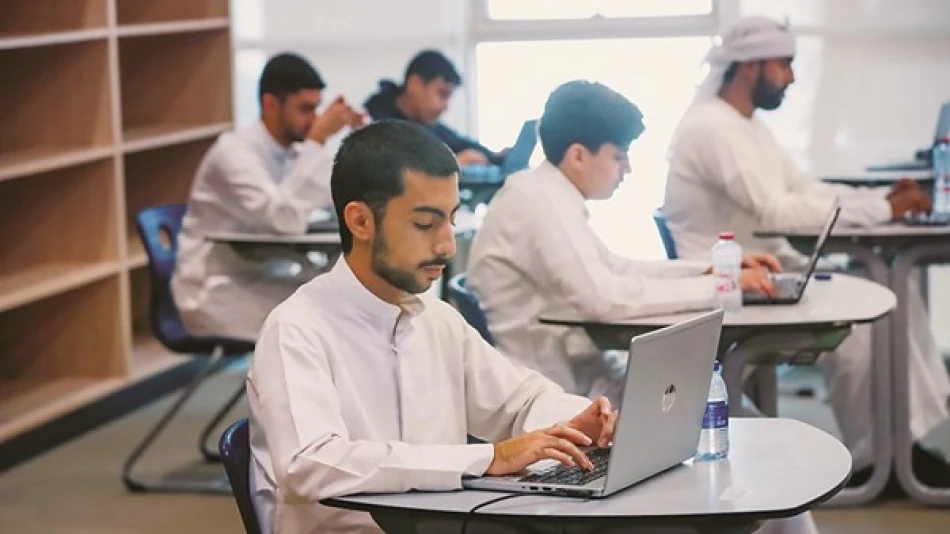
Eleventh-Graders Given Two Weeks to Switch Academic Paths, Says Ministry of Education
UAE Phases Out Elite Track as Education Ministry Streamlines Secondary School System
The UAE Ministry of Education is implementing significant changes to its secondary education structure, eliminating the exclusive "Elite Track" program by 2025-2026 while giving Grade 11 students unprecedented flexibility to switch academic pathways within the first two weeks of the school year. The reforms consolidate the system into two main tracks designed to better align with university admission requirements and career aspirations.
A Strategic Shift Toward Accessibility
The decision to phase out the Elite Track represents a notable departure from the UAE's previous emphasis on creating highly selective academic programs. This move suggests the ministry is prioritizing broader access to quality education over exclusivity, aligning with global trends toward more inclusive educational systems seen in countries like Finland and Canada.
The timing coincides with the UAE's broader Vision 2071 initiative, which aims to make the country the world's best by its centennial. By removing barriers and creating more flexible pathways, the education system appears to be positioning itself to nurture a wider pool of talent rather than concentrating resources on a select few.
The New Two-Track Framework
General Track: Flexibility Meets Practicality
The General Track caters to students interested in humanities, social sciences, arts, and management. Starting in Grade 11, it offers two distinct scenarios that reflect a more nuanced understanding of student interests and capabilities.
The first scenario targets students with humanities and social inclinations, requiring chemistry and biology studies through Grades 11 and 12. The second scenario accommodates students with scientific leanings, allowing them to study physics alongside chemistry in Grade 11, then physics with biology in Grade 12—provided they achieved at least 75% in mathematics and physics during Grade 10.
Perhaps most significantly, Grade 12 students in this track can substitute physics with alternative subjects like arts, health sciences, or Computing, Creative Design, and Innovation (CCDI), though this requires written consent from both student and parent.
Advanced Track: Precision for Professional Pathways
The Advanced Track targets students aspiring to enter demanding fields such as medicine, dentistry, pharmacy, and engineering. This pathway offers two scenarios: studying two core sciences (physics and chemistry in Grade 11, physics and biology in Grade 12) or pursuing all three sciences throughout both final years.
This structure mirrors successful models in Singapore and South Korea, where specialized tracks prepare students for competitive university programs while maintaining academic rigor.
University Alignment Drives Reform
The ministry has strategically aligned these changes with university admission requirements outlined in Ministerial Decision No. 19 of 2024. Medical and dental programs now require 90% in mathematics plus 90% in two of three sciences, while pharmacy demands 80% in mathematics and two sciences. Engineering programs require 80% in mathematics and physics, plus 80% in either chemistry or biology.
This explicit connection between secondary education and higher education admission represents a level of systemic coordination that many education systems struggle to achieve. It should reduce the uncertainty and misalignment that often plague students transitioning from high school to university.
Market and Economic Implications
The reforms signal the UAE's commitment to developing human capital aligned with its economic diversification goals. By creating clearer pathways to STEM careers while maintaining robust options for humanities and creative fields, the system supports the country's ambitions in sectors ranging from renewable energy to cultural industries.
The flexibility built into the system—particularly the two-week window for Grade 11 students to change tracks—acknowledges the reality that career interests often evolve during adolescence. This adaptability could reduce dropout rates and improve student satisfaction, ultimately benefiting the broader economy through better-matched talent.
Implementation Challenges and Opportunities
While the reforms appear well-designed on paper, their success will depend heavily on execution. Schools must be equipped to offer multiple scenarios within each track, requiring careful resource allocation and teacher training. The Applied Track, currently under restructuring for future relaunch, suggests the ministry recognizes that vocational education remains a critical component of a complete system.
The restriction preventing General Track students from transferring to the Advanced Track after Grade 10 maintains academic standards while potentially limiting late bloomers. However, this approach likely ensures that Advanced Track students are adequately prepared for the program's rigor.
Regional Context and Global Trends
These changes position the UAE ahead of many regional neighbors in education reform. While Saudi Arabia and Qatar are also modernizing their education systems, the UAE's combination of flexibility and structure offers a potentially replicable model for other Gulf states.
The emphasis on student choice within structured pathways reflects global best practices from countries like Australia and the Netherlands, where students can customize their education while meeting core requirements. As the region competes for talent and investment, educational quality and flexibility become increasingly important competitive advantages.
 Layla Al Mansoori
Layla Al Mansoori







